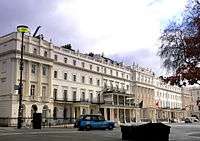Grosvenor Group


The Grosvenor Group is a British property corporation with offices in 18 cities operated on behalf of its owners, the Duke of Westminster and his family. It has four regional investment and development businesses in Britain and Ireland, the Americas, Australia and Asia Pacific; an international fund management business, which operates across these markets and in continental Europe; and a portfolio of indirect investments.
The Grosvenor Estate
The history of the Grosvenor Estate begins in 1677 with the marriage of the heiress Mary Davies to Sir Thomas Grosvenor, 3rd Baronet (1655-1700). Mary had inherited the manor of Ebury, 500 acres of land north of the Thames to the west of the City of London, which remained largely untouched by the Grosvenors until the 1720s, when they developed the northern part - now known as Mayfair – around Grosvenor Square. A few generations later, in the 1820s, their focus moved south - to what is now Belgravia - developing Eaton Square, Chester Square and other famous addresses. Later in the 19th century, the area of Pimlico was developed; this was sold in 1953.
Nomenclature
Many of the streets within the estate are named after the Grosvenor family and its connections. The Grosvenor family became established in England before the 15th century, on the manor of Eaton in Cheshire, where is still located its principal seat Eaton Hall. Many of its early members sat as Member of Parliament for Chester. In 1874 Hugh Grosvenor was created Duke of Westminster; other titles held by the Duke are: Marquess of Westminster, Earl Grosvenor, Viscount Belgrave and Baron Grosvenor. The title Baron Ebury was granted in 1857 to the 3rd son of the 1st Marquess, after the name of the original manor of Ebury (whence Ebury Street, etc. in Pimlico), and the 2nd son of the 1st Marquess succeeded his maternal grandfather under special remainder in 1814 to the title Earl of Wilton (whence Wilton Crescent etc. in Belgravia) [1] "The Cheshire villages of Lupus, Eccleston and Belgrave, within or near the family estate, are recognised in street names of the London estate."[2]
Buildings
The Mayfair portion of the estate includes Peabody social housing around Brown Hart Gardens.
International expansion
Although Grosvenor is often identified with its core asset, the Grosvenor Estate in London, which is now managed within Grosvenor Britain & Ireland, much of the present-day investment and development portfolio is in other parts of Britain and Ireland. International expansion began in the 1950s, in Canada and later in the United States – hence businesses in the Americas. In the 1960s the businesses expanded into Australia and, in the 1990s, into Asia Pacific. Also in the 1990s, Grosvenor expanded into Continental Europe, where most current activity relates to Grosvenor’s fund management business. This was formally established in 2005 and now encompasses the Americas, Asia Pacific (including Australia) and Europe (including the UK).
See also
Other large privately owned historic estates in London include:
- Cadogan Estates (Chelsea, SW1)
- Bedford Estate (Bloomsbury & Covent Garden)
- Portman Estate
- Smith's Charity Estate (South Kensington, SW7)
- Pettiward Estate (West Brompton, SW10)
- Kingston House estate, London (Knightsbridge, SW7)
References
- ↑ Debrett's Peerage, 1968, pp.1147-8
- ↑ Loelia, Duchess of Westminster, Memoirs of, London, 1961, p.174
External links
- Grosvenor Group website
- Grosvenor Group Annual Report & Accounts
- Grosvenor Group Environment Review
- Grosvenor Estate website